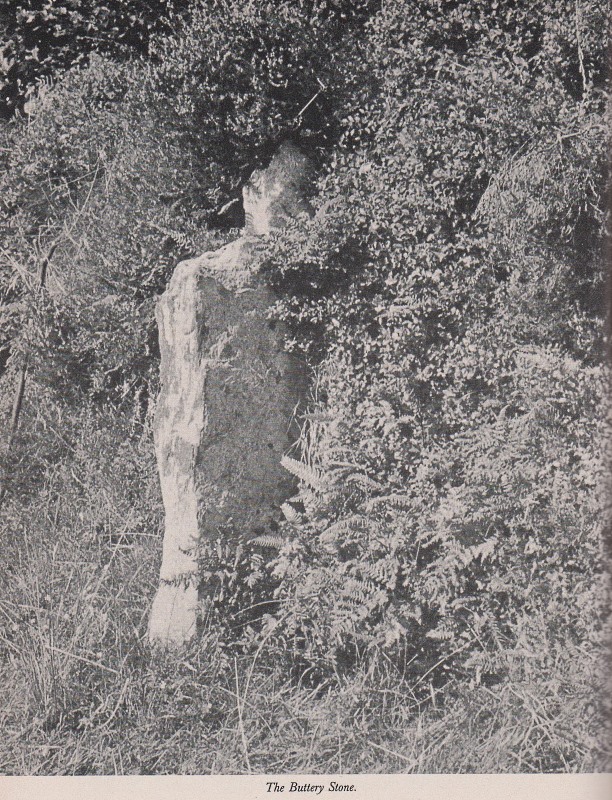[< Gallery Home | Latest Images | Top 100 | Submit Picture >]
260355 Pictures
|
<< Previous Picture | Next Picture >>
Description
Have added The Buttery Stone here in the hopes that The Captain or anyone knowledgeable about Exmoor can check.
In 'Ancient Exmoor' by Hazel Eardley-Wilmot, (The Exmoor Press, 1983), this photo is shown, and a description reads:
"Not all longstones are at stream-heads, and not all the innumerable springs have barrows or stone monuments particularly near them, but where the connection does occur it looks significant. Three especially - Buttery Stone (this one), West Anstey Longstone, and the Caratacus stone on Winsford Hill - have resemblances with the Longstone at the source of the Bray.
The Buttery Stone is a slab protruding slightly from the boundary wall beside the ridge road at Buttery Corner, about a mile south-east of Two Barrrows. (It is not mentioned in the perambulations, though Buttery Corner is; 'Buttewerthe' farm is very old, and was always just outside the Forest, bordering or abutting on it). The stone is at the head of a stream which once carved a deep combe straight down south-westward towards Heasley Mill, and like the Challacombe Longstone, it points down the combe, not along the ridge. Far downhill, the stream is joined by another, from the east, wider but not appreciably longer, which is now mapped as the main stream of the Mole, and they run on SW together. The Mole was once called Nymet, a prehistoric name meaning holy, or divine, surviving in the Nympton village names further down its course. If Bronze Age people, working straight upstream, thought this the real source of their holy river, the position of the Buttery Stone would be on their skyline, and it would invite the reverence of travellers passing along the ridgeway. Like so much else, this is only 'if'. But it might have been. Further downstream, a tributary of the Mole/Nymet has once source in a holy well near North Molton, and still further on the Munson stream flows into it as part of the water of Crooked Oak."
In 'Ancient Exmoor' by Hazel Eardley-Wilmot, (The Exmoor Press, 1983), this photo is shown, and a description reads:
"Not all longstones are at stream-heads, and not all the innumerable springs have barrows or stone monuments particularly near them, but where the connection does occur it looks significant. Three especially - Buttery Stone (this one), West Anstey Longstone, and the Caratacus stone on Winsford Hill - have resemblances with the Longstone at the source of the Bray.
The Buttery Stone is a slab protruding slightly from the boundary wall beside the ridge road at Buttery Corner, about a mile south-east of Two Barrrows. (It is not mentioned in the perambulations, though Buttery Corner is; 'Buttewerthe' farm is very old, and was always just outside the Forest, bordering or abutting on it). The stone is at the head of a stream which once carved a deep combe straight down south-westward towards Heasley Mill, and like the Challacombe Longstone, it points down the combe, not along the ridge. Far downhill, the stream is joined by another, from the east, wider but not appreciably longer, which is now mapped as the main stream of the Mole, and they run on SW together. The Mole was once called Nymet, a prehistoric name meaning holy, or divine, surviving in the Nympton village names further down its course. If Bronze Age people, working straight upstream, thought this the real source of their holy river, the position of the Buttery Stone would be on their skyline, and it would invite the reverence of travellers passing along the ridgeway. Like so much else, this is only 'if'. But it might have been. Further downstream, a tributary of the Mole/Nymet has once source in a holy well near North Molton, and still further on the Munson stream flows into it as part of the water of Crooked Oak."
Posted Comments:
TheCaptain (2018-06-01)
Interesting find Angie. Offhand I know nothing of this stone, but have added its own sitepage from the information given. I'll have a look for the stone on any of the historic records I can find sometime (not so easy as it once was) !
TheCaptain (2018-06-01)
That had me intrigued, and I managed to find more details, now added to the sitepage.
AngieLake (2018-06-01)
Thanks for that Captain! I thought it would interest you. I guess you'll be looking for it next time you go to Exmoor? It is quite an interesting little book. If you haven't got it, I could post it to you?
To post comments first you must Register!

